Biology Unit 3 Macroevolution
1/162
There's no tags or description
Looks like no tags are added yet.
Name | Mastery | Learn | Test | Matching | Spaced |
|---|
No study sessions yet.
163 Terms
If gene flow stops, allele frequencies in isolated populations can…
diverge and populations began to evolve independently (speciation)
Divergence will occur as a result of:
Mutation
Natural Selection
Genetic Drift
may result in speciation
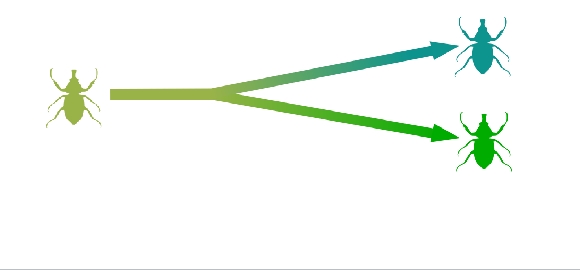
Speciation
a splitting event that creates two or more distinct species from an ancestral species
can occur gradually or abruptly
Approaches for identifying species:
The biological concept
The morphological species (morphospecies) concept
The phylogenetic species concept
According to the Biology species concept, what is the main criterion for identifying species?
reproductive isolation
What is the mating pattern in the Biological Species Concept?
Members of the population do not interbreed
OR
They will fail to produce viable, fertile offspring after mating
Biological Species Concept
reproductive isolation between populations
(they do not breed and do not produce viable, fertile offspring)
Prezygotic Isolation- Biological Species Concept
individuals of different species are prevented from mating successfully
Postzygotic Isolation- Biological Species Concept
hybrid offspring do not survive or reproduce
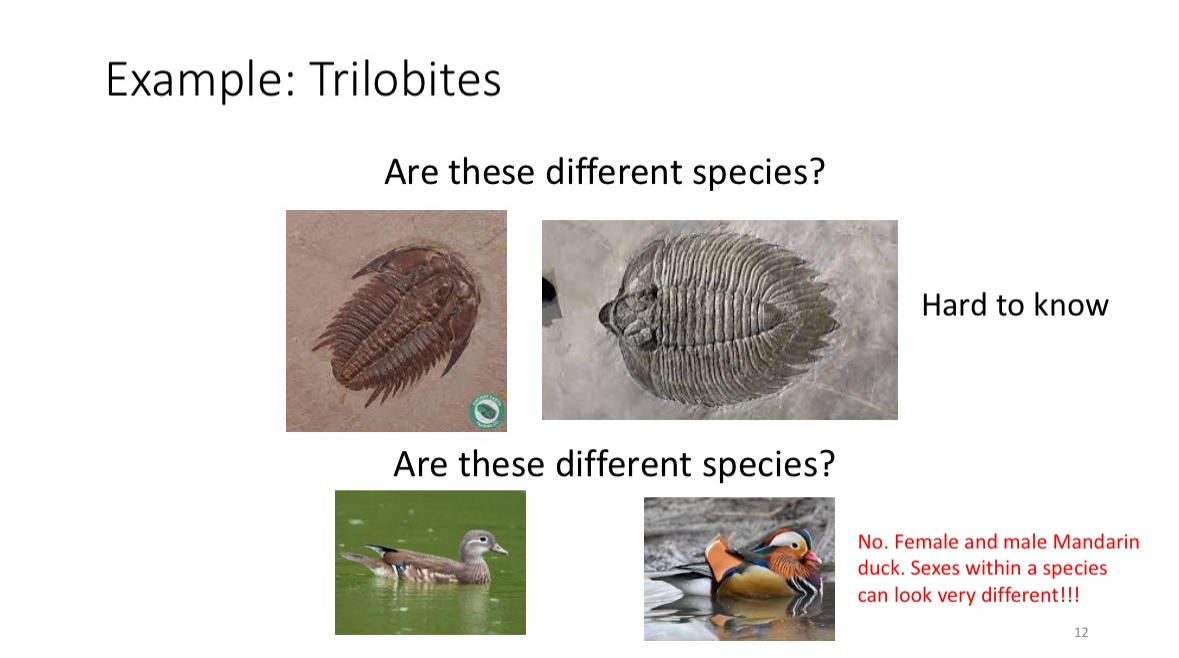
Disadvantages of Biological Species Concept
reproductive isolation cannot be evaluated in fossils and asexually reproducing species
or species that do not overlap geographically
Temporal Isolation- prezygotic isolation mechanism
populations are isolated because they breed at different times
Ex. Spotted skunks that mate at different times of the year
Habitat Isolation- prezygotic isolating mechanism
populations are isolated because they breed in different habitats
Ex. Garter snakes live in different habitats
Ecology is important
Behavioral Isolation- prezyogtic isolation mechanism
populations do not interbreed because their courtship display differs
Ex. Male songbirds sing species-specific songs to attract females
Gametic Isolation- prezygotic isolating mechanism
matings fail because eggs and sperm are incompatible
Ex. differences in the bindin protein determine whether sea urchin sperm will penetrate eggs
Mechanical Isolation- prezygotic isolating mechanism
matings fail because male and female reproductive structures are incompatible
Hybrid Viability- Postzygotic isolating mechanism
hybrid offspring do not develop normally and die as embryos
Ex. when some species of
salamanders mate their offspring
have much lower viability
Hybrid Sterility- postzygotic isolating mechanisms
hybrid offspring mature but are sterile as adults
Ex. Horses and donkeys can mate and produce viable offspring, but their hybrid offspring (mules) are usually sterile
State Haldane’s Rule
“When in the F1 offspring of two different animal races one sex is absent, rare or sterile, that sex is the heterogametic sex.”
Morphospecies Concept
individual lineages differ in size, shape, or other morphological features
distinguishing features likely arise if populations are independent and isolated from gene flow

Disadvantages of Morphospecies Coencept
Subjective
misidentifies polymorphic species (species with same genes but different physical forms)
misses cryptic species (genetically distinct species that appear similar) by not showing obvious physical difference
The Phylogenetic Species Concept
identifies species based on evolutionary history

Monophyletic group
an ancestral population and all descendants
species are defined as smallest monophyletic group on tree of life
also called a clade or lineage
Synapomorphy
trait unique to a monophyletic group (“unique forms”)
Advantages of Phylogenetic Species Concept
widely applicable and based on testable criteria
logical because different species have different synapomorphies due to lack of gene flow and independent evolution and independent evolution
Disadvantages of Phylogenetic Species Concept
few well-estimated phylogenies available
may lead to recognition of many more species than either of the other species concepts
Biological species concept Advantages
Reproductive isolation=evolutionary independence
Morphospecies concept Advantages
Advantages: widely applicable and useful when there is no data on the extent of gene flow
Modes of Speciation
Allopatric speciation
Parapatric speciation
Sympatric speciation
Allopatric Speciation
genetic isolation occurs when populations become geographically separated
populations living in different areas are in allopatry
MOST COMMON MODE
Speciation that begins with geographic isolation is called
Allopatric Speciation
Dispersal- of allopatric speciation
a population moves to a new habitat, colonizes it, and finds a new population
colonization events can lead to speciation
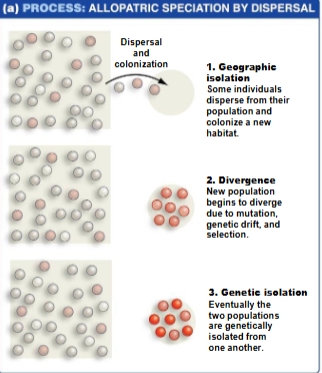
Vicariance- of allopatric speciation
the physical splitting of a habitat
a physical barrier like a mountain range uplifting or a river splitting the geographic range of species
Ex. researchers compared DNA sequence of trumpeters from different areas of the Amazon basin to the geological events that occurred (isolated populations due to vicariance)
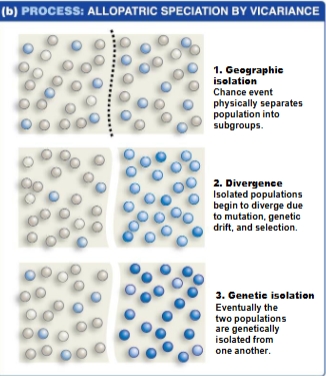
Biogeography
study of how species and populations are distributed geographically
can tell us how dispersal and vicariance events occur
In Parapatric Speciation, how does divergence (genetic isolation) occur?
gradually along an environmental gradient (cline)
latitude or elevation impose a gradient of selection pressures which changes phenotypes and genotypes as result (Ex. House mice increase in body size in the north)
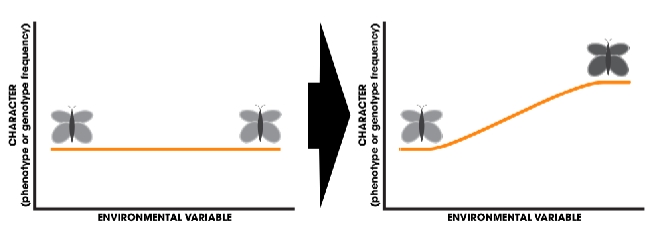
Sympatry
populations or species that live in same geographic area or close enough to interbreed
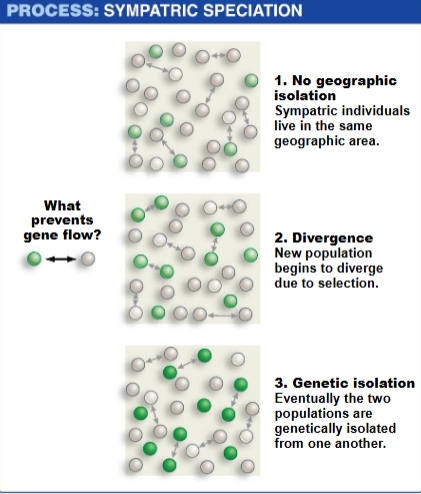
Sympatric Speciation can be initiated by two types of events:
(1) External events: Disruptive selection based on different ecological niches or mate preferences
(2) Internal events: Chromosomal mutations (polyploidy)
The apple maggot fly adapted to different host fruits within the same area. This is an example of:
sympatric speciation via disruptive selection
sympatric populations may be reproductively isolated by adapting to different habitats
can cause rapid divergence, affects gene flow via prezygotic isolation
A niche
range of ecological resources that a species can use and the range of conditions it can tolerate
Conclusion for Disruptive Selection in flies
hybrid individuals do not orient to fruit scent as well as parents leading to them having a lower reproductive success
thus, disruptive selection has led to sympatric speciation
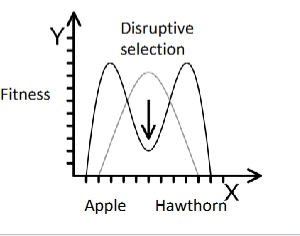
Sympatry
populations or species that live in the same geographic area— close enough to interbreed
Polyploidy
a mutation that causes instant speciation
results in more than two sets of chromosomes
Sympatric Speciation by Polyploidy -Autopolyploid
Autopolyploid (oneself)
doubles chromosome number
chromosomes are all from the same species (self-fertilization)
reproductively isolated from original population
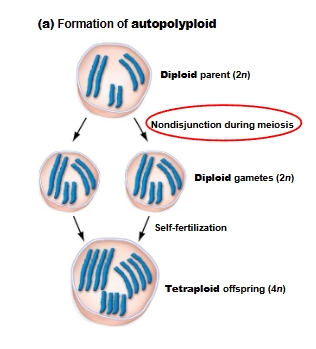
Sympatric Speciation by Polyploidy- Allopolyploid
Allopolyploid (different)
different species mate and there are different chromosome numbers resulting in viable, nonsterile offspring
new tetraploid species can be created when two diploids hybridize (usually offspring are sterile)
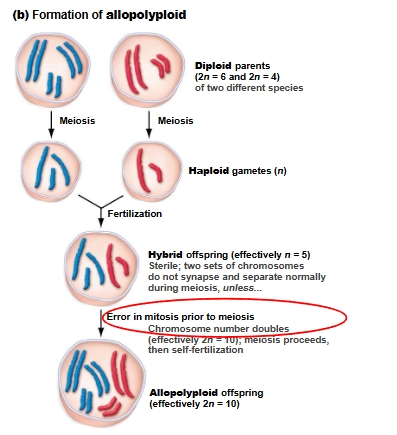
What is “instantaneous speciation”?
autopolyploids cannot interbreed with original species after a single generation of self-fertilization (instantaneous speciation)
How are Allopolyploid species created?
new tetraploid species created when two diploid species hybridize resulting in sterile offspring
if error occurs during mitosis creating diploid gametes in adult offspring, meiosis proceeds, gametes fuse, and create tetraploid individuals
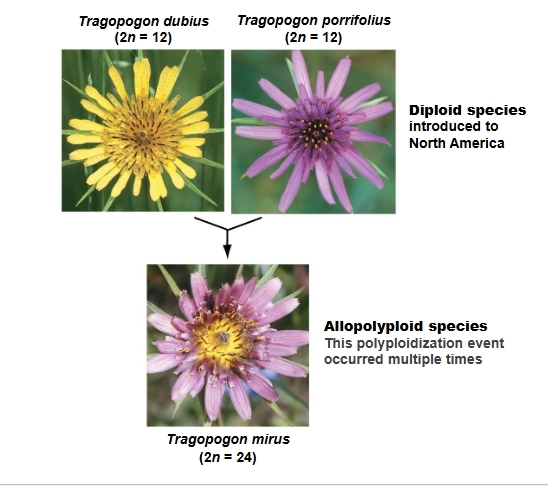
Advantages of being polyploid
higher levels of heterozygosity than diploids
tolerate high levels of self-fertilization w/o inbreeding depression
genes on duplicated chromosomes can diverge independently
If divergence and prezygotic isolation exist, then
mating between the populations is rare, populations continue to diverge
When prezygotic isolation does not exist, then
populations may interbreed which may erase distinctions between the two populations
can lead to reinforcement and hybrid zones
According to reinforcement, if two populations have diverged extensively and are genetically distinct, what will happen?
the fitness of hybrid offspring will be lower than parents’ fitness
Reinforcement
natural selection for traits that prevent interbreeding among populations (selection for prezygotic isolating mechanism)
is shown for species that overlap geographically
Hybrid Zones
a geographic area where interbreeding between two populations occurs
can be narrow or wide, long or short lived, and stable in one place or move over time
Example of Hybrid Zones
Townsend Warblers and Hermit Warblers hybridize extensively where their ranges overlap
hybrid offspring have intermediate traits relative to two parental species
Data from Mitochondrial DNA in Warblers show
most hybrids form when Townsend Warbler males’ mate with Hermit Warbler females
Townsend males invade Hermit territories, drive off Hermit males, and mate with Hermit females
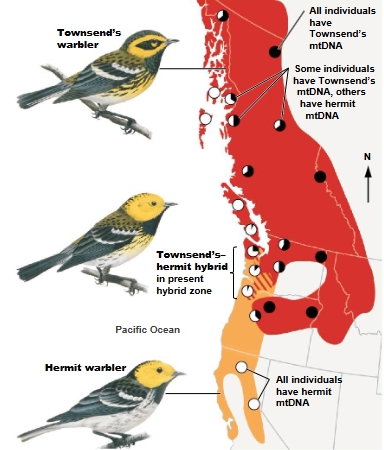
Phylogenetic Trees
shows evolutionary relationships among genes, species, and higher taxa
most universal tree is the tree of life which depicts evolutionary relationships among all organisms
Phylogenetic Tree Symbols and Definitions
Branch: represents a population through time
Node: represents a point where a branch splits— most recent ancestor
Tip: represents endpoint of branch— either a living or extinct taxon
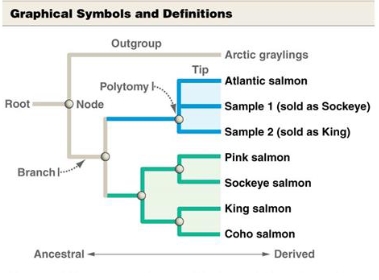
Phylogenetic Symbols and Definitions continued
Root: most ancestral branch
Outgroup: a taxon that diverged before taxa of interest, “roots” tree
Polytomy: node that divides into 3 or more branches
Taxa are always located where on phylogenetic trees?
branch tips: never within tree because they are not ancestor of others
closely related taxa depicted as sister groups that share a recent common ancestor
On a phylogenetic tree, what do nodes represent?
speciation events
tree can rotate around any node— resultant trees are equivalent
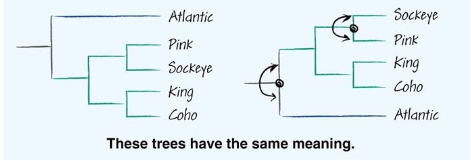
A Character
A character or trait is any genetic, morphological, physiological, or behavioral characteristic that is studied
has two possible states: present (1) or absent (0)
Outgroup
is a sister group sharing a recent common ancestor with taxa being studied but is not part of study group
establishes whether a trait is ancestral or derived
can evolve, do not represent ancestors of other taxa
Ancestral trait
a character that existed in an ancestor
Derived trait
modified form of ancestral trait, found in a descendant (mutation, selection, genetic drift occurs)
Homology
similarity in organisms due to common ancestry
(trait A is homologous among the red branches)

Synapomorphy
shared, derived trait shared by 2 or more descendant taxa
(trait A occurs only in red branches)
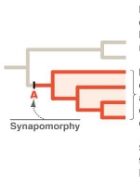
Paraphyletic group
includes ancestral population but not all of descendants

Homoplasy
similarity not due to common ancestor and therefore require >1 evolutionary step
(trait B arose twice independently)

Polyphyletic group
does not include the most recent common ancestor, arise from convergent evolution (have independent traits)
(shown in purple)
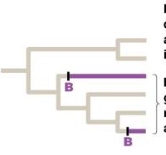
What is the difference between traits that are Homologies vs ones that are Homoplasies?
Homologies are traits shared among related species
Homoplasies are traits that unrelated species shared (Ex. wings in birds and flies drawn by convergent evolution)
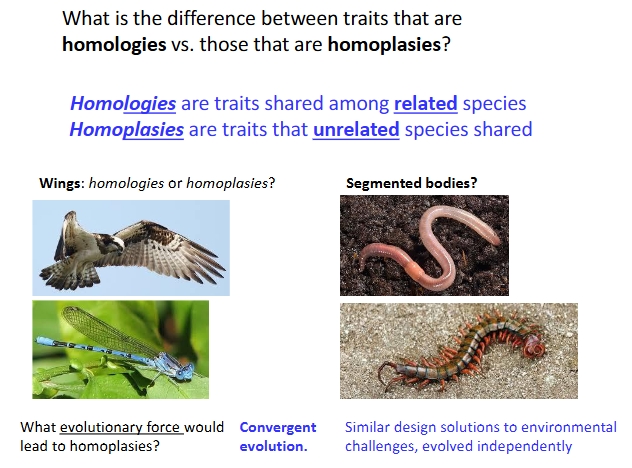
Parsimony
implies the least number of evolutionary changes most accurately reflects what occurred during evolution
Characters on Trees
show branching patterns
A repeated trait that is the result of independent evolution and not shared ancestry is referred to as:
homoplasy
When evaluating DNA sequences between species, the fewest sequence differences suggests
a closer relationship (parsimonious)
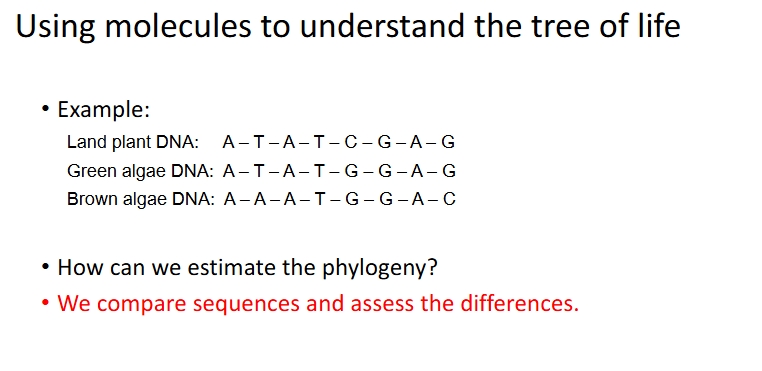
Phylogeny DNA Sequence Example
summarize data by differences
Land — Green: 1
Green — Brown: 2
Land — Brown: 3
most closely related are land pants and green algae, sharing a recent common ancestor
Males are sterile in XY taxa, which are
flies and mammals
Females are sterile in ZW taxa, which are
birds and butterflies
Sympatric Speciation
speciation that occurs among populations within the same geographical area
(1) No geographic isolation
(2) Divergence due to selection
(3) Genetic Isolation
When using DNA for Phylogenetics, what occurs more frequently?
1) Transitions (A-G or C-T) more frequent than Transversions (other combos)
2) Synonymous (does not change protein) are more frequent than Nonsynonymous (may change protein, subjected to natural selection)
What is the Molecular Clock?
rate at which mutations accumulate in DNA within a species.
used to estimate nodes on tree by using geological events
most changes are ‘neutral’
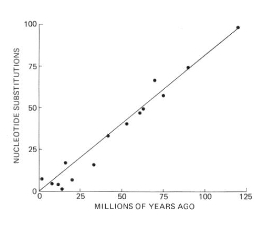
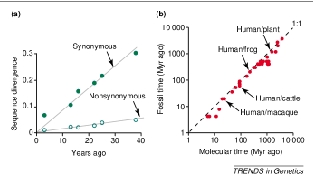
species that are more divergent at the sequence level share a more distant common ancestor
What is the divergence rate for the cox1 gene in a beetle?
3.5% My^-1, the DNA sequence of the cox1 gene changes by 3.5% every million years between lineages

What is the ‘S’ region and why is there so much nucleotide diversity?
It is the Spike protein; which facilitates virus entry into healthy cells
Fossil
physical evidence from an organism that lived in the past
How are fossils formed?
when part or all of an organism is buried in sediment
Intact fossils
form when decomposition does not occur and organic remains are preserved
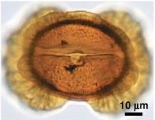
Compression Fossils
form when sediments accumulate on top of the organism and become cemented into rocks
sediments’ weight compresses organic material below into a thin, carbonaceous film
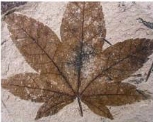
Cast Fossils
form when remains decompose after burial and dissolved minerals create a cast in remaining hole
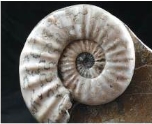
Permineralized fossils
form when remains decompose slowly, dissolved minerals slowly infiltrate the cells’ interior and harden into stone
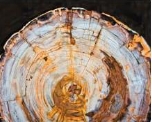
Trace fossils
form when sedimentation and mineralization preserve indirect evidence of an organism
Ex. Footprints, tracks, burrows, feeding marks, and feces
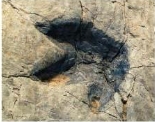
How can the age of species be estimated if it is new?
its age can be estimated based on the age of nearby rock layers
Fossils form under ideal conditions, which means:
they must be buried rapidly
they must decompose slowly
fossilization is a rare event
Habitat bias- limitation of fossil record
organisms living where sediment is actively being deposited (beaches and swamps) are more likely to fossilize than are organisms in other habitats
burrowing organisms are more likely to fossilize than aboveground organisms
Taxonomic and Tissue Bias- limitation of fossil record
some organisms with bones or shells are likely to decay slowly and leave fossil evidence
tissues with a tougher outer coat that resists decay (pollen) fossilize more readily
Temporal Bias- limitation of fossil record
recent fossils are more common than ancient fossils
Abundant Bias- limitation of fossil record
organisms that are abundant, widespread, and present for a long time leave evidence more often than species that are rare or local
Ex. crinoids
When did Earth start to form? When did life start?
4.6bya/3.5-3.8bya
How is Earth’s history divided into?
Precambrian
Paleozoic era
Mesozoic era
Cenozoic era
Precambrian Era
from Earth’s formation (4.6 bya) to appearance of most animal groups (543 mya)
unicellular until late
oxygen absent for 2 billion years, until evolution of photosynthetic bacteria
Describe the three eras of the Phanerozoic Eon?
Paleozoic- most major animal lineages and diversification of land animals (fungi and land plants), ending with removal of almost all multicellular life
(543-248 mya)
Mesozoic- begins with paleozoic extinction ends with extinction of dinosaurs, abundance of dinosaurs and gymnosperms
(252-66 mya)
Cenozoic- mammals and gymnosperms
(66 mya-present)
The history of life on earth consisted of a series of
Adaptative Radiations <—> Extinctions
Adaptative Radiations
the rapid production, from a single lineage, of many descendant species